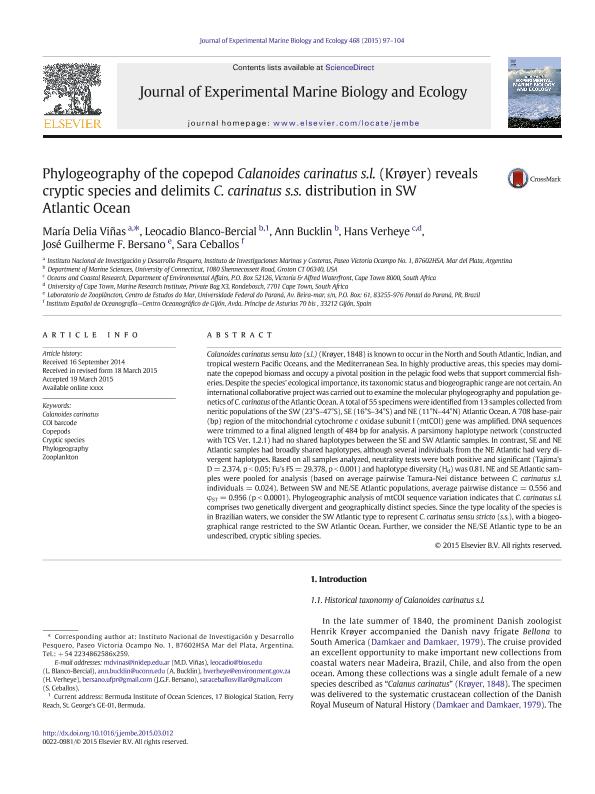Mostrar el registro sencillo del ítem
dc.contributor.author
Viñas, Maria Delia

dc.contributor.author
Blanco Bercial, Leocadio
dc.contributor.author
Bucklin, Ann
dc.contributor.author
Verheye, Hans
dc.contributor.author
Bersano, José Guilerme F.
dc.contributor.author
Ceballos, Sara
dc.date.available
2018-05-28T20:27:38Z
dc.date.issued
2015-07
dc.identifier.citation
Viñas, Maria Delia; Blanco Bercial, Leocadio; Bucklin, Ann; Verheye, Hans; Bersano, José Guilerme F.; et al.; Phylogeography of the copepod Calanoides carinatus s.l. (Krøyer) reveals cryptic species and delimits C. carinatus s.s. distribution in SW Atlantic Ocean; Elsevier Science; Journal of Experimental Marine Biology and Ecology; 468; 7-2015; 97-104
dc.identifier.issn
0022-0981
dc.identifier.uri
http://hdl.handle.net/11336/46346
dc.description.abstract
Calanoides carinatus sensu lato (s.l.) (Krøyer, 1848) is known to occur in the North and South Atlantic, Indian, and tropical western Pacific Oceans, and the Mediterranean Sea. In highly productive areas, this species may dominate the copepod biomass and occupy a pivotal position in the pelagic food webs that support commercial fisheries. Despite the species´ ecological importance, its taxonomic status and biogeographic range are not certain. An international collaborative projectwas carried out to examine the molecular phylogeography and population genetics of C. carinatus of the Atlantic Ocean. A total of 55 specimenswere identified from13 samples collected from neritic populations of the SW (23°S?47°S), SE (16°S?34°S) and NE (11°N?44°N) Atlantic Ocean. A 708 base-pair (bp) region of the mitochondrial cytochrome c oxidase subunit I (mtCOI) gene was amplified. DNA sequences were trimmed to a final aligned length of 484 bp for analysis. A parsimony haplotype network (constructed with TCS Ver. 1.2.1) had no shared haplotypes between the SE and SW Atlantic samples. In contrast, SE and NE Atlantic samples had broadly shared haplotypes, although several individuals from the NE Atlantic had very divergent haplotypes. Based on all samples analyzed, neutrality tests were both positive and significant (Tajima´s D=2.374, p b 0.05; Fu´s FS=29.378, p b 0.001) and haplotype diversity (Hd) was 0.81. NE and SE Atlantic samples were pooled for analysis (based on average pairwise Tamura-Nei distance between C. carinatus s.l. individuals = 0.024). Between SW and NE/SE Atlantic populations, average pairwise distance = 0.556 and φST = 0.956 (p b 0.0001). Phylogeographic analysis of mtCOI sequence variation indicates that C. carinatus s.l. comprises two genetically divergent and geographically distinct species. Since the type locality of the species is in Brazilian waters, we consider the SW Atlantic type to represent C. carinatus sensu stricto (s.s.), with a biogeographical range restricted to the SW Atlantic Ocean. Further, we consider the NE/SE Atlantic type to be an undescribed, cryptic sibling species.
dc.format
application/pdf
dc.language.iso
eng
dc.publisher
Elsevier Science

dc.rights
info:eu-repo/semantics/openAccess
dc.rights.uri
https://creativecommons.org/licenses/by-nc-sa/2.5/ar/
dc.subject
Calanoides Carinatus
dc.subject
Coi Barcode
dc.subject
Cryptic Species
dc.subject
Phylogeography
dc.subject
Zooplankton
dc.subject.classification
Otras Ciencias Biológicas

dc.subject.classification
Ciencias Biológicas

dc.subject.classification
CIENCIAS NATURALES Y EXACTAS

dc.title
Phylogeography of the copepod Calanoides carinatus s.l. (Krøyer) reveals cryptic species and delimits C. carinatus s.s. distribution in SW Atlantic Ocean
dc.type
info:eu-repo/semantics/article
dc.type
info:ar-repo/semantics/artículo
dc.type
info:eu-repo/semantics/publishedVersion
dc.date.updated
2018-05-21T16:55:04Z
dc.journal.volume
468
dc.journal.pagination
97-104
dc.journal.pais
Países Bajos

dc.journal.ciudad
Amsterdam
dc.description.fil
Fil: Viñas, Maria Delia. Consejo Nacional de Investigaciones Científicas y Técnicas. Centro Científico Tecnológico Mar del Plata. Instituto de Investigaciones Marinas y Costeras. Subsede Instituto Nacional de Investigación y Desarrollo Pesquero; Argentina
dc.description.fil
Fil: Blanco Bercial, Leocadio. University of Connecticut; Estados Unidos
dc.description.fil
Fil: Bucklin, Ann. University of Connecticut; Estados Unidos
dc.description.fil
Fil: Verheye, Hans. Oceans and Coastal Research; Sudáfrica
dc.description.fil
Fil: Bersano, José Guilerme F.. Universidade Federal do Paraná; Brasil
dc.description.fil
Fil: Ceballos, Sara. Instituto Español de Oceanografía; España
dc.journal.title
Journal of Experimental Marine Biology and Ecology

dc.relation.alternativeid
info:eu-repo/semantics/altIdentifier/url/https://www.sciencedirect.com/science/article/pii/S0022098115000738
dc.relation.alternativeid
info:eu-repo/semantics/altIdentifier/doi/http://dx.doi.org/10.1016/j.jembe.2015.03.012
Archivos asociados
